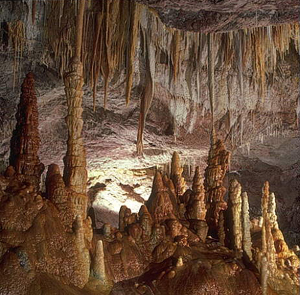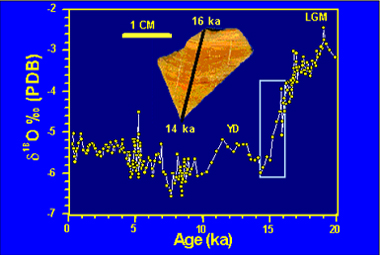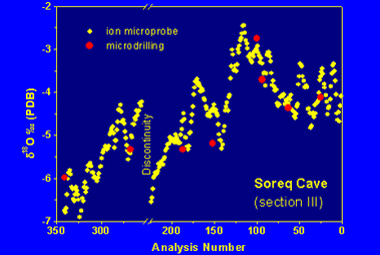Paleoclimatology

Oxygen and carbon isotopic variations in speleothems (i.e., stalagmites) potentially provide one of the best proxy records of climate change during the Quaternary (e.g., Hendy and Wilson, 1968; Hendy, 1971, Schwartcz, 1986, Gascoyne, 1992; Hellstrom et al., 1998; Bar-Mathews et al., 1999; Wang et al., 2001). Oxygen isotopes contain an integrated record of ambient temperature and groundwater composition, while carbon isotopes preserve information regarding soil-zone carbon dioxide dynamics (e.g. vegetation and groundwater through flow rates). If the various contributions can be deconvolved, valuable paleotemperature data can be obtained. Dr. Pauline Treble, a former UCLA post-doctoral researcher affiliated with the ion microprobe laboratory studied the micron-scale relationships between oxygen and carbon isotope (and trace element) cycles with recorded climate variables (e.g., surface temperature variations, rainfall record). The goal of her research was to decouple the cave temperature and precipitation signals in speleothem oxygen isotope records and thereby verify and validate these proxy climate records.
Growth rates of speleothems vary considerably, but are typically a few to 10's of microns per year. Thus traditional methods involving gas-source mass spectrometric measurement of δ18O and δ13C and U-series dating typically provide data averaged over 50-200 year periods and thus temporal resolution of the onset of regional and global climate change at the century level. Techniques such as laser ablation-gas chromatography-mass spectrometry (e.g., McDermott et al., 2001) have increased this resolution significantly. For example, applying this approach to a fast growing speleothem, Ku and Li (1998) obtained a temporal resolution of 3 years over the last 500 years. However, to routinely access records containing decadal to century-scale oscillations shorter requires the highest possible spatial resolution. The ion microprobe is capable of obtaining isotope ratio measurements in geological materials with lateral spatial resolution of ~10 µm (Huneke et al., 1983; Compston et al., 1984) - and potentially two orders of magnitude higher than that in depth profiling mode. While ion microprobe methods are currently capable of routinely attaining ± 0.5‰ precision for oxygen and carbon isotope ratio measurements in carbonates (e.g., Mahon et al., 1998) continued development of multi-collection detection systems promises to improve that, bringing the external precision close to that routinely achieved by conventional methods and permitting subtle paleoclimate signals to be documented.
We have undertaken two feasibility studies to assess the capability of the high resolution ion microprobe in this role. In collaboration with Yehoshua Kolodny obtained a portion of a speleothem (2-N) from the Soreq cave, Israel, that had been well-characterized by conventional stable isotopic and U-series methods (Bar-Mathews et al., 1999). The cave is located in a dolomitic host rock, and speleothem deposition has been essentially continuous for the last 185 ka. Being at the termination of North Atlantic storm tracks, but free of permanent ice cover during the Last Glacial Maximum, this location has been used to advantage to assess Northern European climate histories during the Quaternary. A δ18O record was obtained by ion microprobe (Kolodny et al., 2003) on portions of the stalactite which were deposited during the time interval of 18 to 14.3 ka, 10.8 to 8.5 and 1.5 to 0.2 ka with temporal resolution ranging from ~1 year to 25 years (depending on the deposition rate during the period investigated). Below, we focus on the period between 16 ka to 14 ka over which the δ18OPDB composition was observed in conventional measurements to decrease in a broadly linear fashion from - 4‰ to - 6‰:

Last 20 ka record of δ18OPDB for a speleothem from Soreq cave, Israel obtained using a mm-scale drill and conventional gas source mass spectrometry (Bar-Matthews et al., 1999). Note that between 16 ka to 14 ka, the oxygen isotopes decrease 2‰ towards lighter values in a broadly linear fashion. |

Portion of the Soreq cave speleothem shown in inset corresponding to the period 16 ka to 14 ka before present. While conventional, mm-scale measurements of δ18OPDB show a general increase in this period, the ion microprobe data reveal a complex cyclicity with a period of ~150 years. |